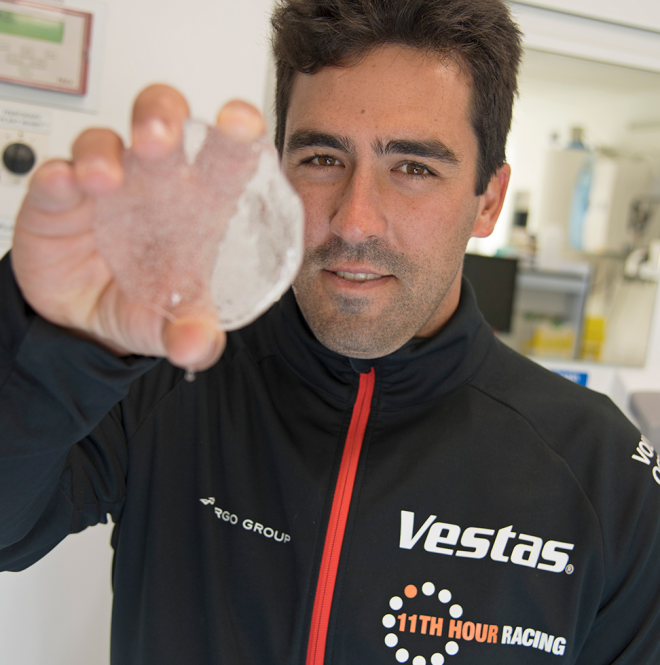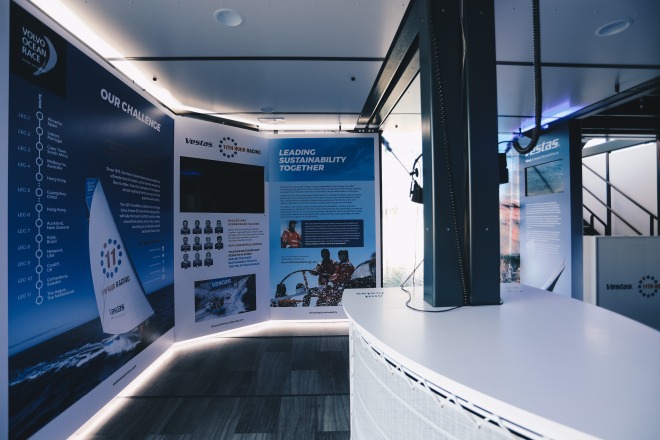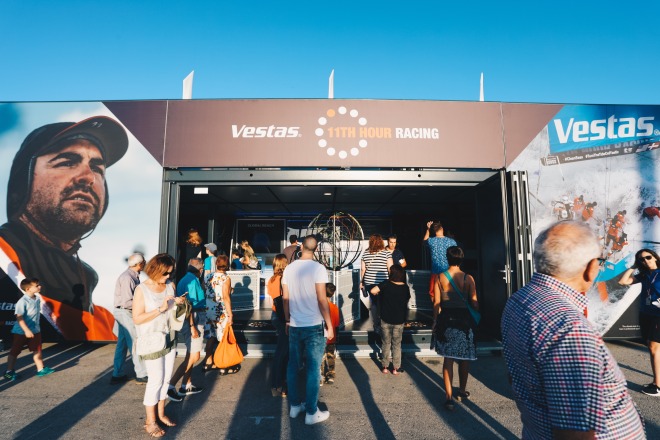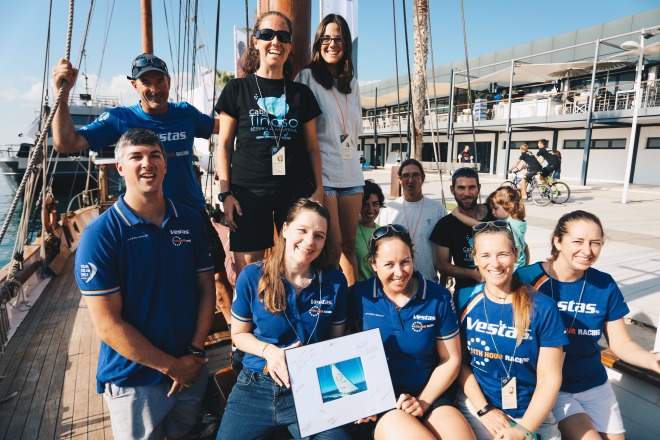Since 2013, GreenSportsBlog has featured the teams and athletes leading the sports-greening movement. What we haven’t focused on is their work on the field.
So in September, we launched GSB Eco-Scoreboard: Catching Up with Green-Sports Leaders on the Field, an occasional series highlighting recent on-field/court results of the greenest teams and athletes. Why? Because if they do well, their green messages will gain a wider audience. And it provides much needed fun, something the climate change/environmental world can use more of.
Here is our third entry.
Stephen Piscotty, Oakland A’s
Those who’ve read our first two eco-scorecards and/or our profile of Stephen Piscotty last January will notice that the 26 year-old eco-outfielder is no longer a member of the St. Louis Cardinals.
The Stanford grad — with a degree in Atmosphere and Energy Engineering, Piscotty and a serious interest in solar and smart grid technology — was traded last month by the Cardinals to the Oakland A’s for two minor league prospects.

Eco-athlete Stephen Piscotty was traded from St. Louis to Oakland in December (Photo credit: Charles LeClaire/USA TODAY Sports)
On the surface, this looks like a strictly baseball move: After a stellar rookie year in 2016, Piscotty had a rough 2017: Two stints on the disabled list with hamstring and groin injuries combined with a sophomore slump at the plate led to a brief demotion to Triple-A Memphis in August.
But there is much more to the move to the Bay Area for Piscotty than just baseball.
Piscotty received news over Memorial Day 2017 that his mother, Gretchen, who resides with Stephen’s dad in the Bay Area an hour’s drive from Oakland, had been diagnosed with ALS^ or Lou Gehrig’s Disease.
Cardinals’ president of baseball operations John Mozeliak was quoted in a USA TODAY story by Jorge L. Ortiz at the time of the trade as saying, “There were certainly some opportunities to move [Piscotty] elsewhere, and when you’re looking at how to break a tie, clearly [his mom’s illness] did play into it.’’
St. Louis’ compassionate approach towards Piscotty elicited praise from Billy Beane#, the A’s executive VP of baseball operations: “That’s what makes the Cardinals one of the classiest organizations in sports.”
Amen to that!
Gretchen Piscotty faces a very rough road ahead so it is a great thing that her son will be close by when the A’s are at home. Here’s hoping Stephen Piscotty rebounds with a strong 2018.
Vestas 11th Hour Racing In Contention After Three Legs of Volvo Ocean Race
Vestas 11th Hour Racing, the sailing team trying to win the ’round-the-world Volvo Ocean Race (VOR) while being its most sustainable squad, is in the mix after three of the race’s 12 legs.
Led by skipper Charlie Enright and team director Mark Towill, the team is tied for second position in the seven boat field. After winning the first leg from Alicante, Spain to Lisbon, Vestas 11th Hour Racing earned third place in both the second (Lisbon-Cape Town) and third (Cape Town-Melbourne) chapters. The teams left Melbourne to start the fourth leg on January 2 for Hong Kong, with expected arrival on January 15.
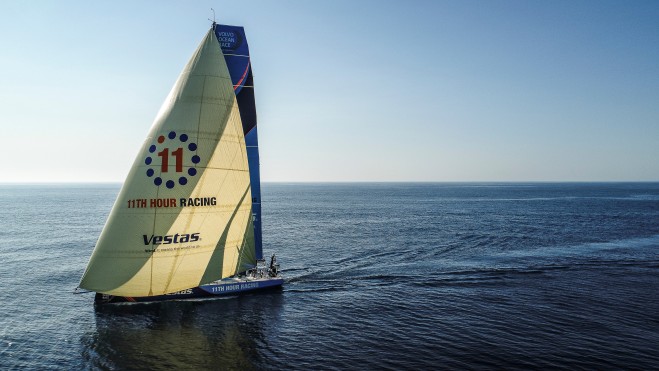
The Vestas 11th Hour Racing team during the first leg of the Volvo Ocean Race in October (Photo credit: Martin Keruzore/Volvo Ocean Race)
Perhaps the main reason Enright, Towill & Co. have a solid chance to succeed on and off the water is the unique collaboration taking place between sport, business (Vestas, the largest wind turbine maker in the world) and philanthropy (11th Hour Racing, an organization that promotes ocean health by serving as sustainability consultant to elite sailing teams). The partnership resulted in a set of best-in-class set sustainability initiatives for Vestas 11th Hour Racing, including:
- The calculation and offsetting of the team’s carbon footprint by tracking emissions related to travel, accommodations, electricity usage, water consumption and waste.
- Outfitting each team member with a “sustainability kit” containing refillable water bottle, coffee mug, bamboo toothbrushes, and a personal water filter.
- Eliminating single-use plastics and straws
- Being ‘plastic negative’ by removing more trash from beach cleanups than they create during the race.
- Communicating the team’s vision of a cleaner, healthier environment to fans at race stops via an interactive Exploration Zone and during the race through its website, social media, and the #LeadingSustainability hashtag.
After Hong Kong, the race heads to Guangzhou (China) and back to Hong Kong. Then it’s on to Auckland (New Zealand), Itajaí (Brazil), Newport (Rhode Island, USA), Cardiff (Wales) and Gothenberg (Sweden), before finishing in The Hague (Netherlands) in June.
Three Mid-to-Lower Tier English Football Clubs Doing Great Green Things
Three English football (soccer) clubs, which currently reside between the fourth and sixth levels of the “Pro/Semi-Pro Football Pyramid,” (incredibly, there are 24 tiers) have earned our consistent attention by their innovative Green-Sports leadership off the pitch. Let’s see how they’re doing on it.
Forest Green Rovers (League Two*, English football’s fourth tier)
Forest Green Rovers (FGR) is the Greenest Team in Sports — earning that distinction in a myriad of ways, from solar powered “Mow-Bots” used to manicure the organic pitch at The New Lawn stadium to all vegan-only concession stands.
FGR took a major step up on the pitch in 2017, earning promotion from the fifth to the fourth tier of English football — the highest rung achieved in the club’s 125-year history — in a May playoff match at London’s Wembley Stadium. The trick for FGR this season is to stay in the fourth tier and avoid relegation down from whence they came. Their task is clear: finish above the bottom two places in the 24-team league when the campaign ends in May.
It’s been quite a struggle, especially lately: A 2-1 home loss to Wycombe on New Year’s Day, the club’s sixth in seven matches (the other match ended in a draw), put FGR at the bottom of the table/standings just past the season’s halfway point. A quick turnaround was needed and FGR delivered with Saturday’s taut 1-0 home win vs. 13th place Port Vale.
The club’s first win of the new year came courtesy of a goal from the newly acquired Reuben Reid. Per the official match report, the game-winner came in the 61st minute as “Reid picked the ball up 25 yards from goal and thundered a sensational left footed effort into the top corner.” Port Vale had several late chances for an equalizer but FGR held on for the win and the vital three points that went with it.
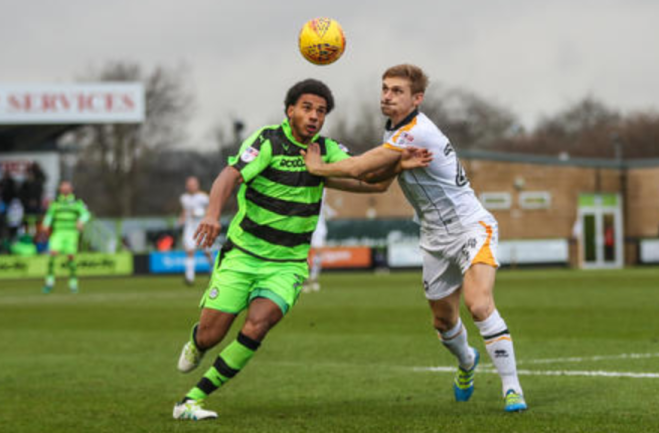
Reuben Reid (l) of Forest Green Rovers scored the game-winner in Saturday’s 1-0 home win vs. Port Vale
The win moved FGR up two slots to 22nd place, just out of the dreaded “Relegation Zone,” at least for now. Can the lads keep it up? We shall see, starting with Saturday’s tilt at 10th place Swindon Town.
Sutton United (National League*, fifth tier)
Just south of Wimbledon resides Sutton United F.C. and its 5,000 seat Gander Green Lane, the first football stadium to achieve The Planet Mark™ sustainability certification##. Reducing its carbon footprint by 13.6 percent in 2016 and diverting 88 percent of its waste from landfill helped the club earn the designation.
On the pitch, Sutton United is threatening to join Forest Green Rovers in the fourth tier next season — that is, if FGR can stay up. The Amber & Chocolates sit in third place in the National League, within shouting distance of second place and a promotion spot. They started the 2018 portion of their campaign just like they ended 2017 — hot — with a 2-1 win at Gateshead.
The sprint to season’s end in May picks up on Saturday when promotion rival Dagenham & Redbridge comes to Gander Green Lane.
Dartford F.C. (National League South*, sixth tier)
Dartford Football Club in Kent, 18 miles southeast of London, has always toiled in the middle-lower rungs of the English football pyramid, usually between the fifth and eighth tiers.
But the club’s 4,100-seat Princes Park, which opened in 2006, is definitely top tier, sustainability-wise: It was the UK’s first sustainable, purpose-built, small-sized stadium, featuring on-site solar panels, energy efficient lighting, a state-of-the-art green roof, and an advanced reclaimed rainwater system.

Princes Park, with its distinctive and state of the art green roof, serves as the home of Dartford F.C. in Kent England (Photo credit: Sustainability in Sport)
On the pitch, Dartford is having a fine season. Since a loss on December 9, the club has gone unbeaten in its last six matches to move into first place in the sixth tier. First and second place finishers get promoted to the fifth tier.
Only six points separates first to eighth place so the battle for the two promotion slots is tight. Dartford can separate themselves from the pack a bit on Saturday when fourth place Havant & Waterlooville% comes to Princes Park.
^ ALS = Amyotrophic Lateral Sclerosis
# Billy Beane is also the metrics-oriented GM who was portrayed by Brad Pitt in the movie Moneyball
* The top six tiers of English football are, from first to sixth: Premier League, Championship, League One, League Two, National League, and National League South/National League North
## Planet Mark is a four year-old British sustainability certification system
% Havant & Waterlooville is one of the great team names in sports.
Please comment below!
Email us: lew@greensportsblog.com
Friend us on Facebook: http://facebook.com/greensportsblog
Tweet us @GreenSportsBlog

